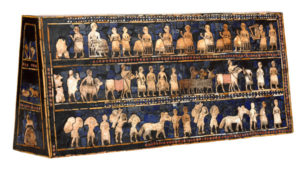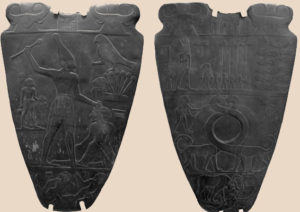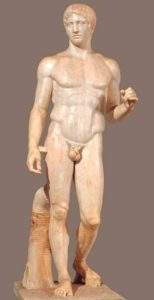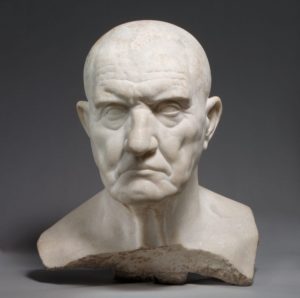In unit 2, we explored art within Ancient civilizations, including Mesopotamia, Egypt, Greece, and Rome. Much like everything else, the history of their art also provided us with insight into the state of their society and environment, as well as their beliefs and values. These civilizations had many similarities and differences in their art, which also reflects what they considered to be of importance.
One of the most common theme amongst the art of the ancient world was religion. The Mesopotamian’s and the Egyptians were similar in the fact that their “Gods” often had animalistic features. This was a way to create obvious distinction between the power and status of the Gods and humans. We can also see the blatant socioeconomic differences between rulers and common civilians in both of these civilizations art. The Standard of Ur, from the Royal Tombs at Ur, is a good example of Mesopotamian art that depicts this. With two sides to the “standard” we can see the two sides of life at the time: peace and war. Not only does the standard depict order and chaos but it also makes the concepts of the class and hierarchal system of the society more evident. The people (and animals) on the bottom level, who are the common people are less detailed, while the people on the top who are royalty are much more detailed. This is similar to the Egyptian Palette of King Narmer, because it also portrays scenes of war, power, and hierarchy. Narmer, who was royalty and the Falcon, who was a God are both the biggest and most detailed are in the top level, to show their importance. Meanwhile, those on the bottom are much less important as they appear dead. This kind of art was common and showed that the people during this time valued royalty and religion. It also allows the audience a peek into the significant details and lifestyles of the civilizetions.



The Greek and Romans, unlike the Egyptians and Mesopotamians, embraced humanist concepts more frequently. They believed that embracing the human qualities was important and portrayed their Gods to have such qualities. While the Greeks used their ability to illustrate motion and stance in their more idealized versions of the human body, the Romans on the other hand chose to make their sculptures appear more lifelike by focusing on the details of the human body and face and not shying away from the “flaws” of humans. For example, Polykleitos’ Doryphoros represents the Greeks’ idealistic image of the male body. Doryphoros’ contrapposto stance, with his weight resting on one leg and his shoulders more balanced, provided a more realistic stance than those of sculptures from earlier civilizations. Nevertheless, where his body exuded strength, power, and athleticism, his face lacked any distinguishable features.

Despite taking inspiration from the Greeks, the Romans looked past the practically unattainable “perfect” male bodies, choosing to focus more on the imperfect human aspects. They even made sure their Gods were portrayed wearing clothes rather than complete nakedness. The Romans chose to go with the concept of portraiture because it reflected their goals as a Republic. They were eager to represent themselves with balding heads and wrinkles which they viewed as a way of showing wisdom and hard work rather than flaws.


Wow, loved how you compared the standard of Ur and the Palette of Narmer. Both pieces of art really give viewers a perfect understanding of how their society and culture revolved around royalty and Gds.